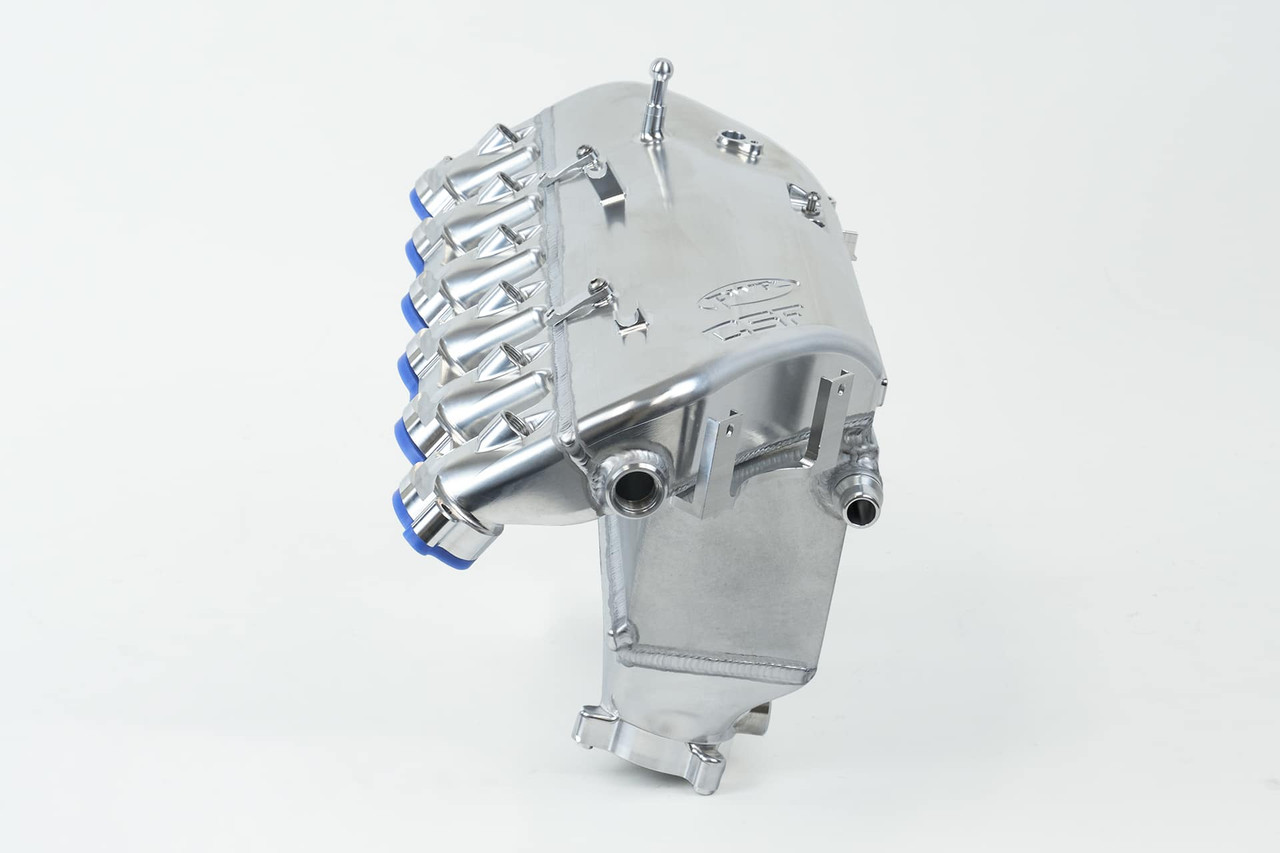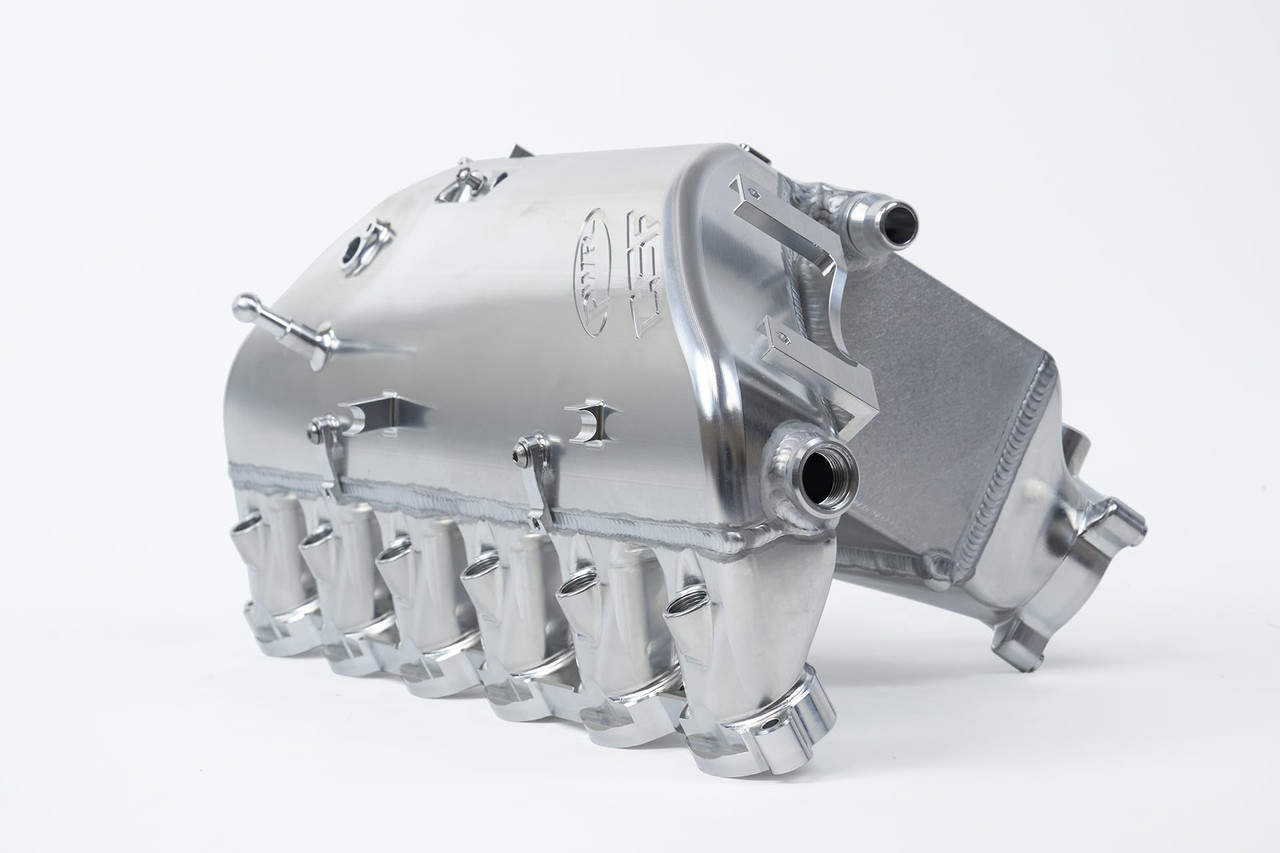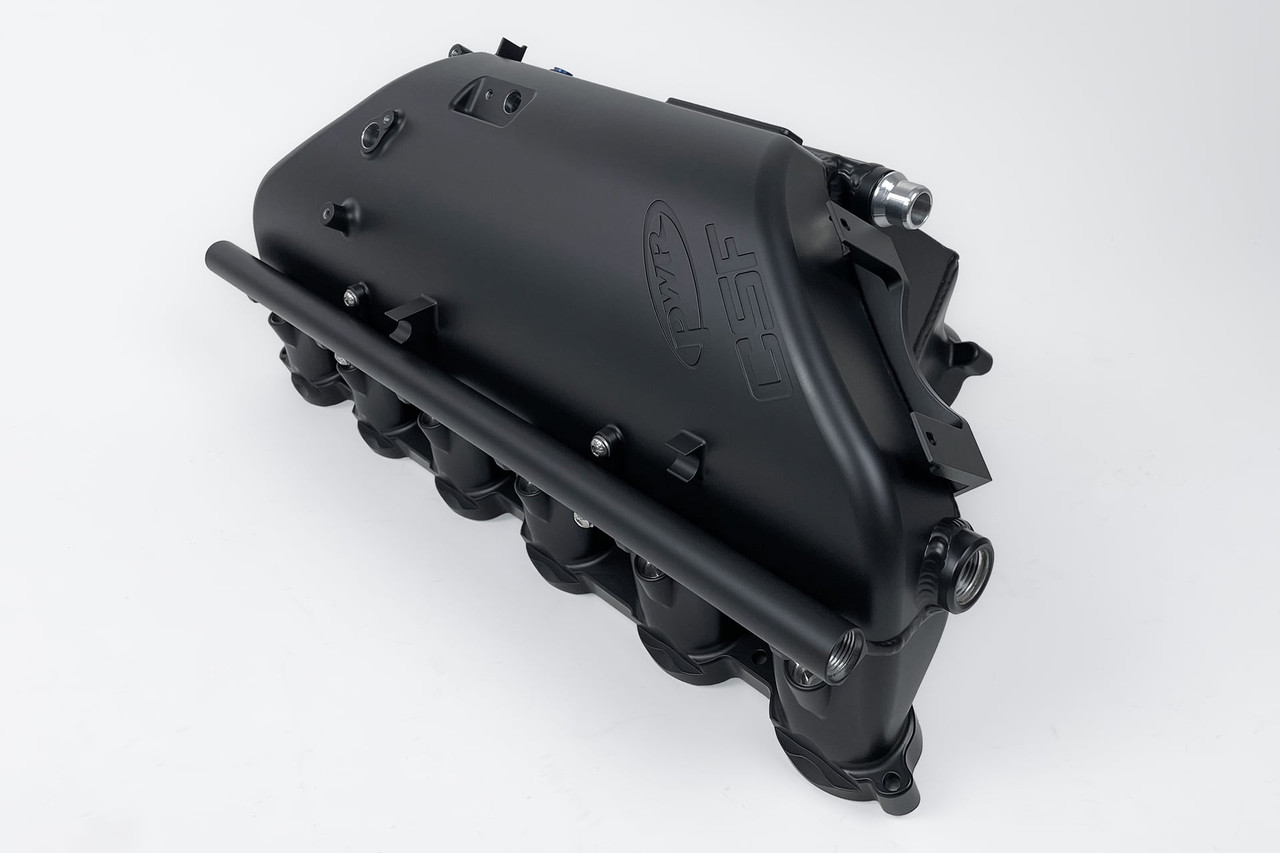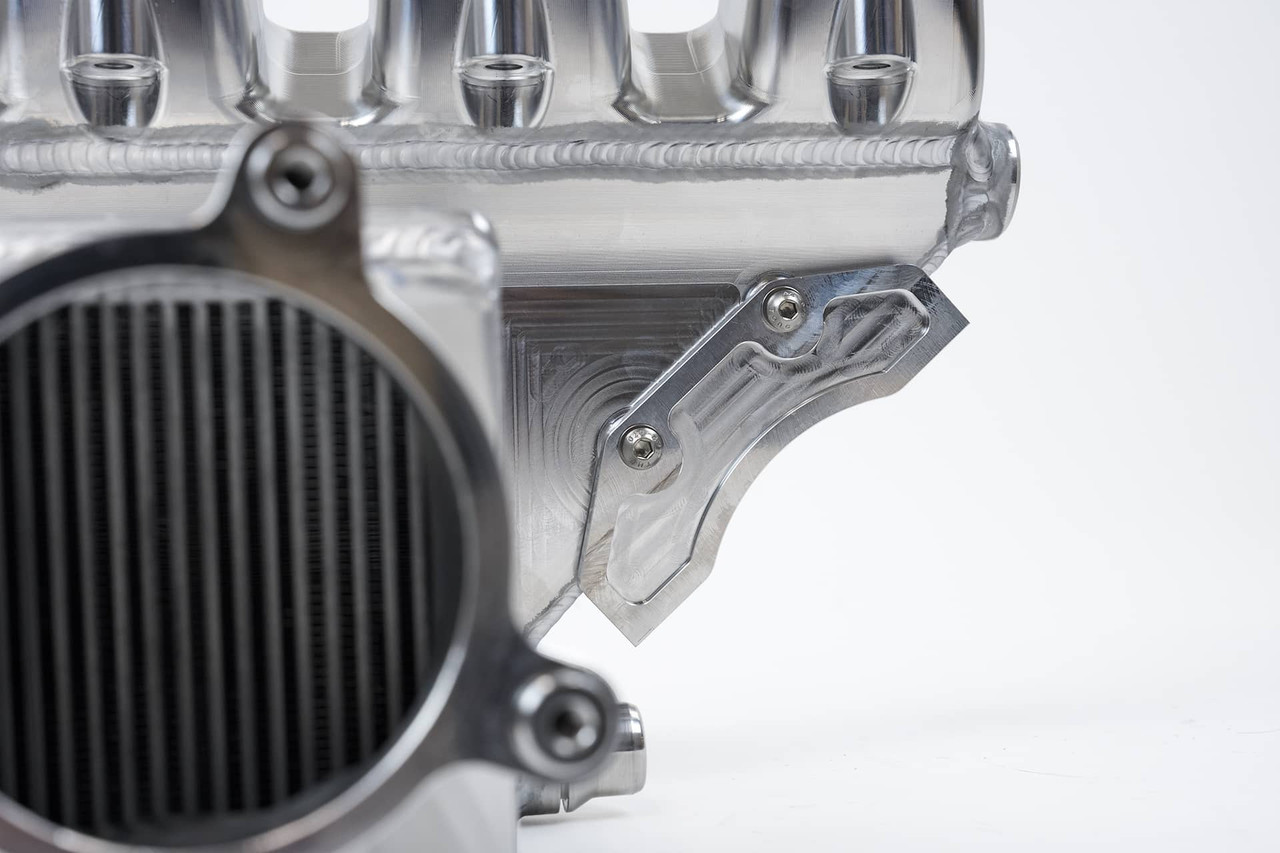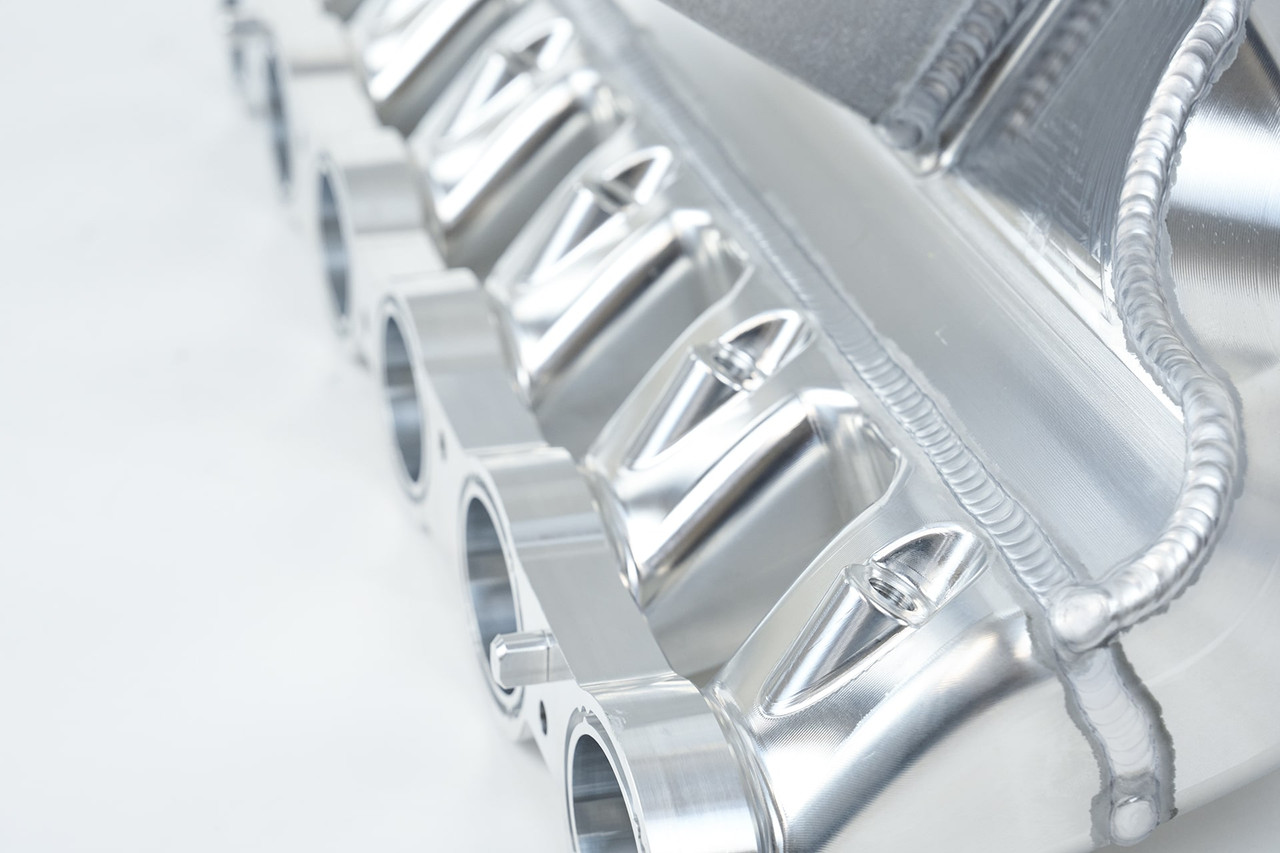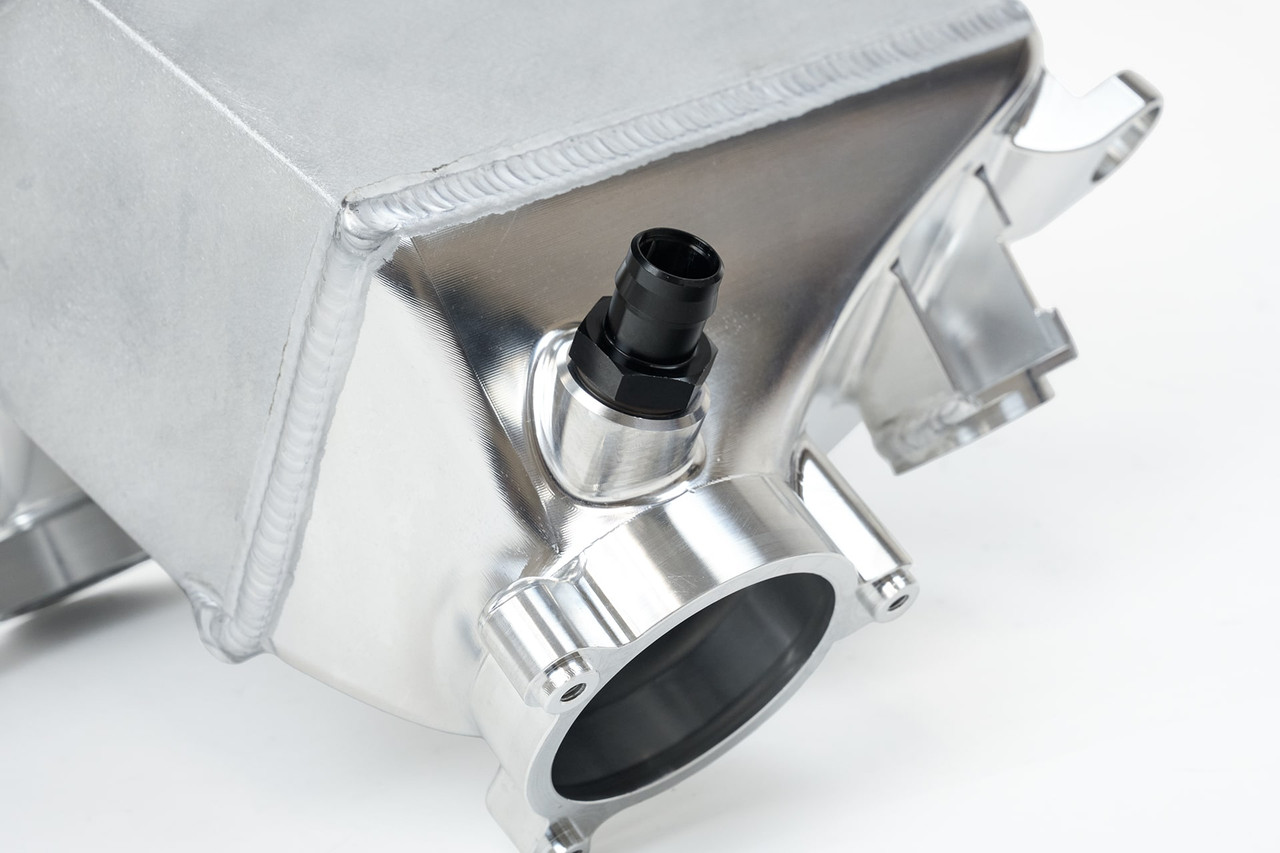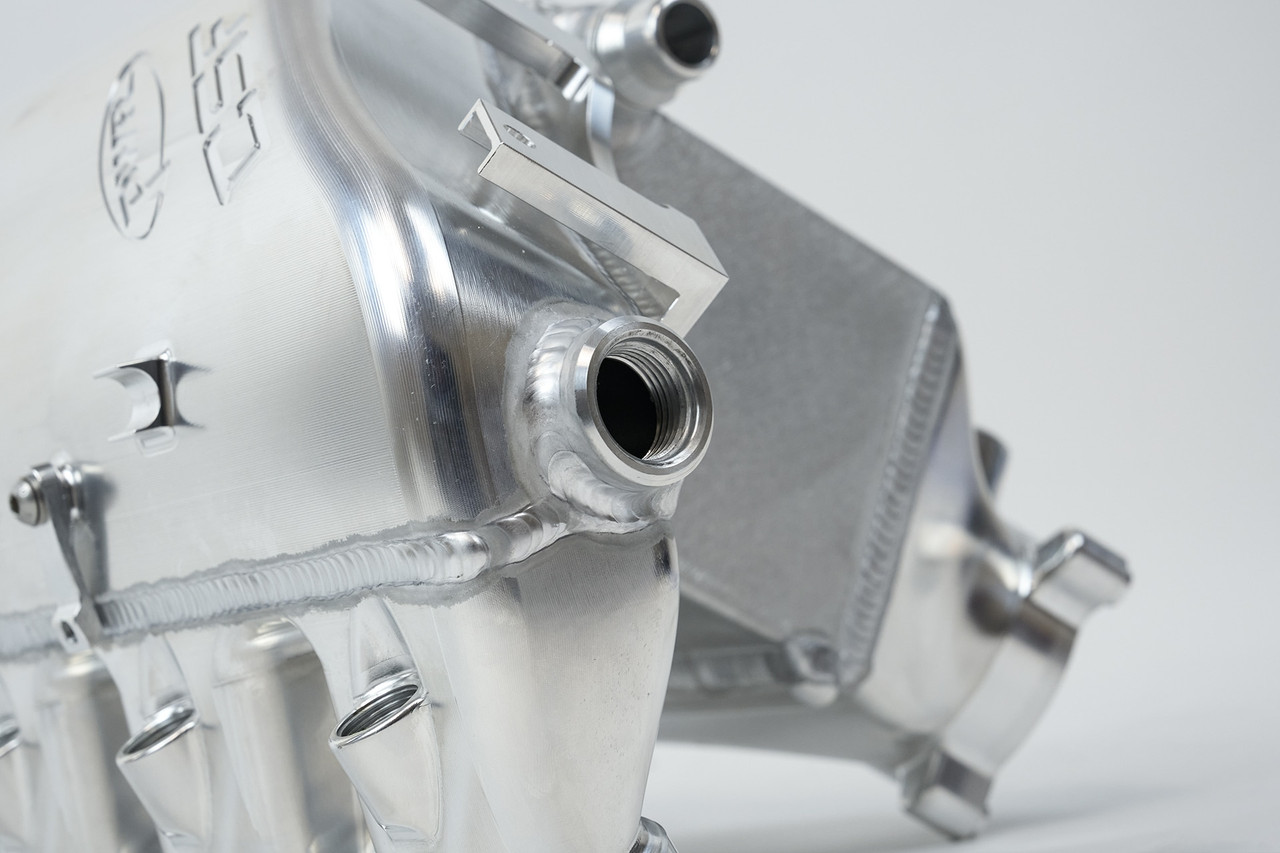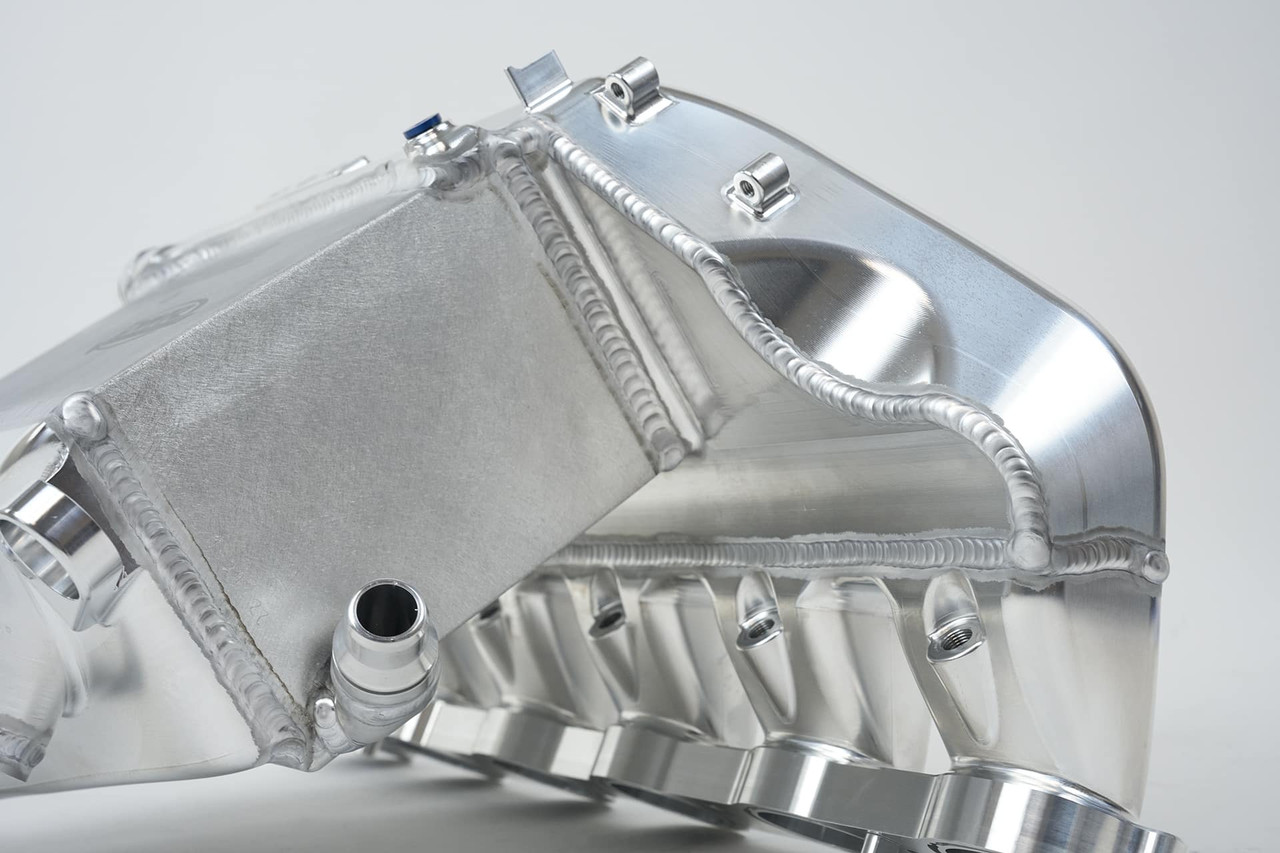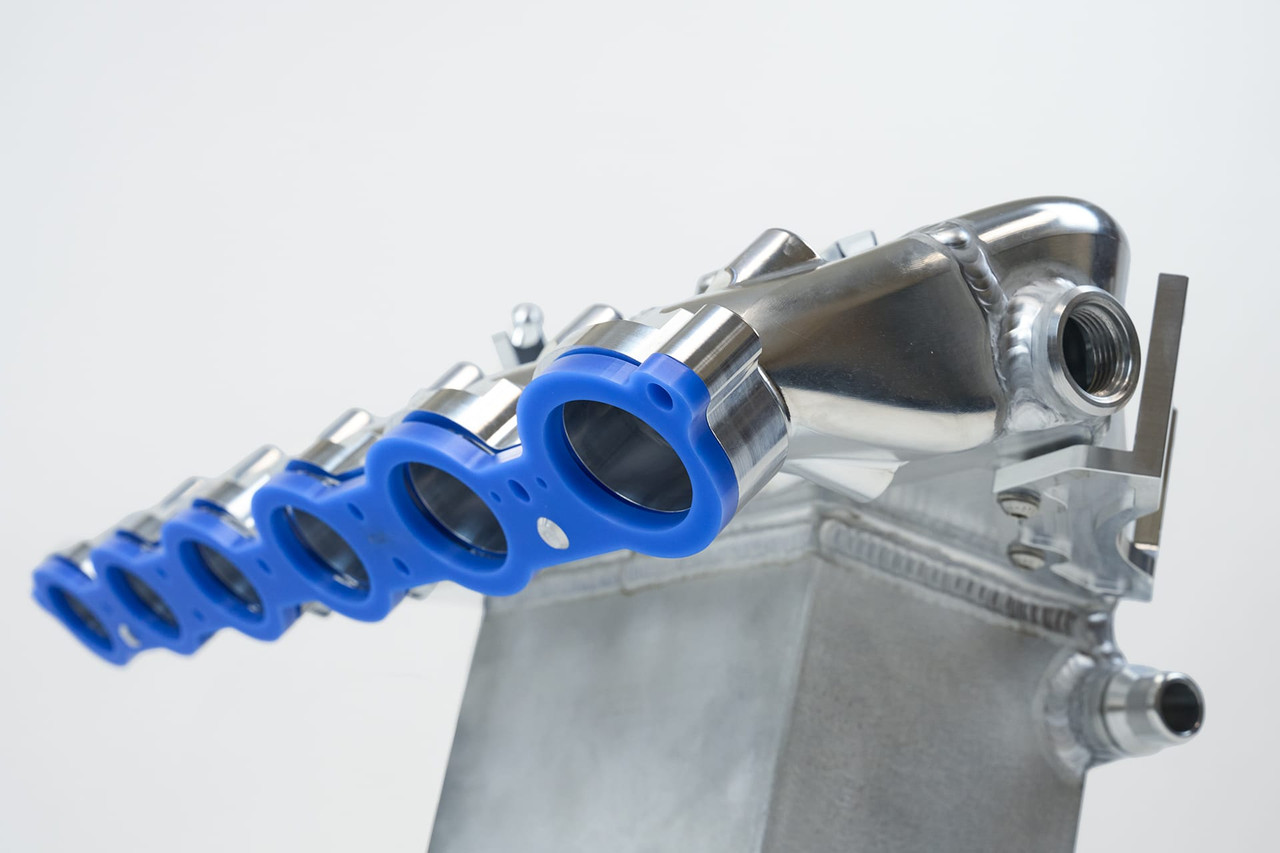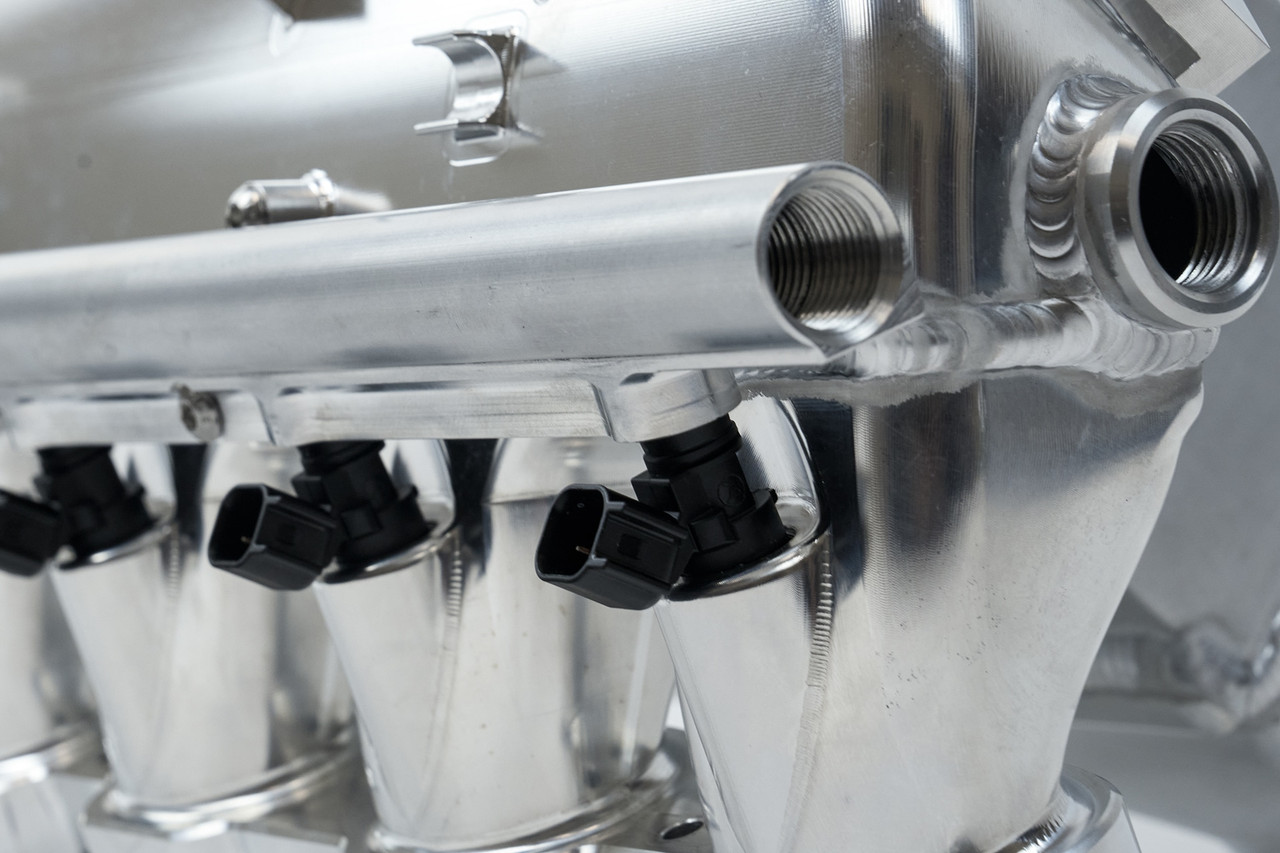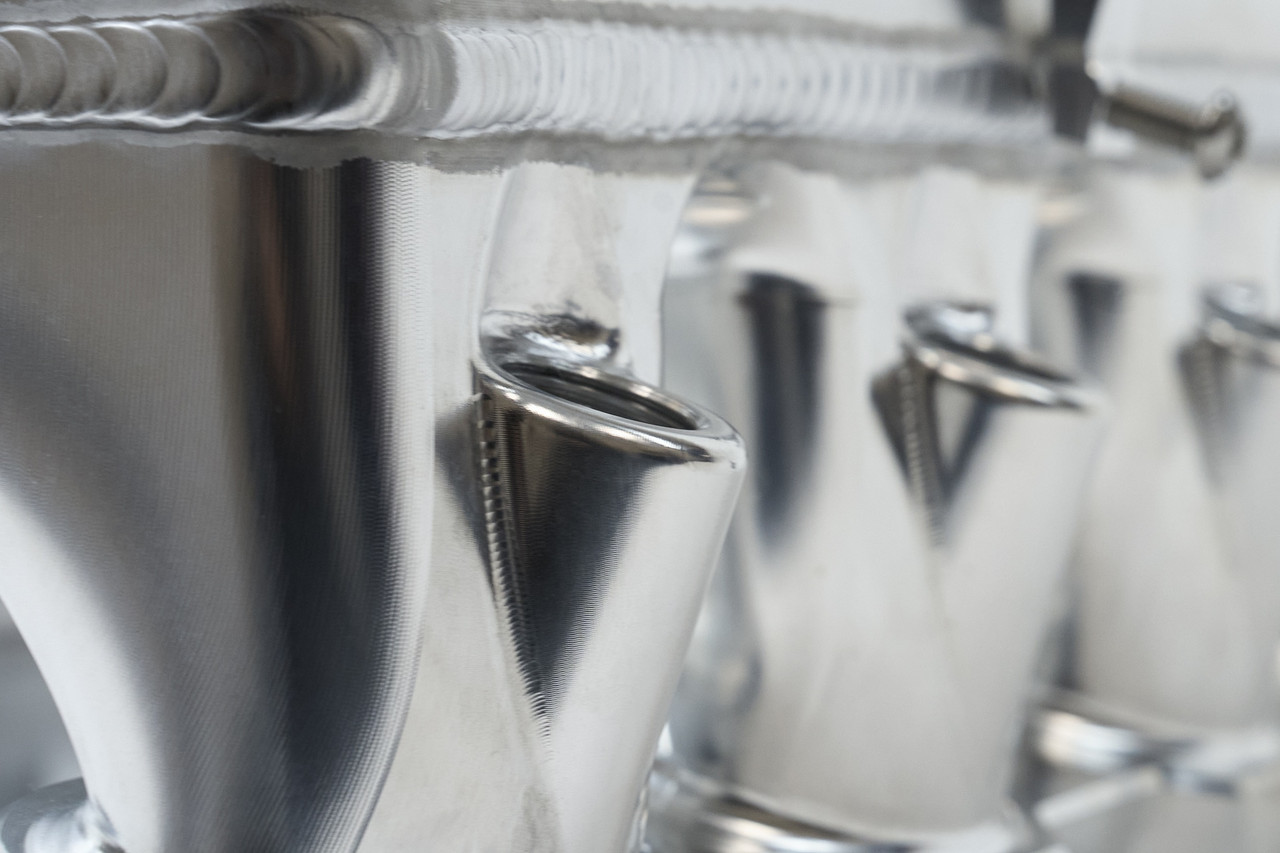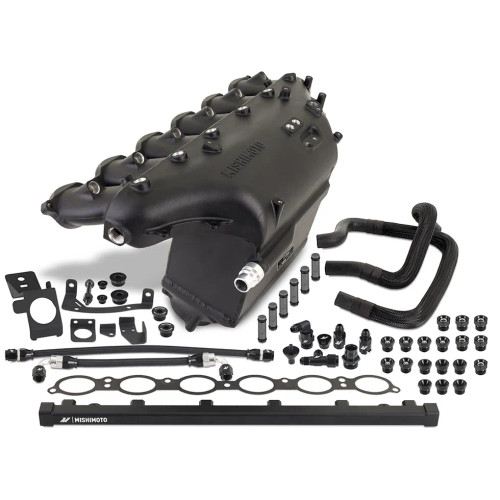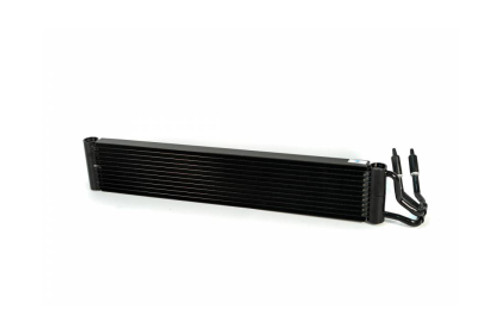Product Description
- ~30°F reduction of Intake Air Temperatures (IATs) compared to OEM
- Less pressure drop compared to OEM core
- Puts less stress on the turbo system and allows more boost to be made at higher target power levels
- Ultra strong CNC Billet construction replaces weak plastic tanks with crimped-on gasket sealing core.
- High performance bar/plate intercooler core by PWR pressure tested to 120psi
- OEM cooler is a tube/fin core which is prone to failing at pressures over ~27psi
- Top feed port injection w/ included fuel rail (w/ CNC machined block-off caps included for non-use)
- Integrated Nitrous/Methanol Injection Ports
- Individual ports for each runner for maximum control
- Integrated vacuum and parameter pad to measure additional parameters
- Easy access to spin-off oil filter
- Integrated breather port for easy bleeding of air from the water side of the manifold
- Included KIYLEX Thermal Rejection Manifold Spacer
- Made from KIYLEX® – A patented revolutionary high-performance final stage polymer
- Acts as a thermal barrier that dissipates heat between the cylinder head and intake manifold
- Proven to lower intake manifold temperatures by up to 15%
- Lowers Intake Air Temps (IATs)
- All necessary brackets, hardware, and instructions to install
- Raw Billet Aluminum Finish (#8233)
- Thermal Black Heat Dispersion Powder-Coating Finish (#8233B)
- Available in custom colors from the leader in BMW cooling customization (#8233C)
- True Plug-and-Play “Drop-in Fit” Installation – Requires Absolutely No Modifications.
- OEM level of fit and finish
- Limited Lifetime Warranty
1. The custom-spec, Air-to-Water, Charge-Air-Cooler, Bar/Plate Core

| OEM BMW Charge-Air-Cooler Specs | CSF Charge Air-Cooler-Specs | |
|---|---|---|
| Weight | 4.68 kg (10.32 lbs) | 7.42 kg (16.36 lbs) |
| Airside Fin height | 5.75 mm | 2.43 mm |
| Waterside Fin Height | 2.75 mm | 2.00 mm |
| Air Rows | 27 | 48 |
| Water Rows | 28 | 49 |
| Core Size | 142 mm x 230 mm x 99 mm 3233.34cc |
152mm x 239 mm x 110 mm 3996.08cc (23.6% more volume) |
The CSF by PWR bar/plate intercooler core is far superior to not only the OEM extruded tube/fin core, but also without a doubt, will outperform any competitor in the performance aftermarket by a long shot. Let’s first discuss the competitive advantages of the CSF by PWR core, and then we’ll pick apart the competition using their own published information.
The CSF by PWR Advantage
PWR manufactures this core in-house at its tier-1 OEM manufacturing facility in Indianapolis, USA. Each core is built by hand to aero-space level specifications and tolerances. What separates the core technology of PWR from the rest of the world is its ability to source and use extremely lightweight and thin materials in its cores. This allows for the absolute highest level of thermal transfer between the charge-air, and the water used as the medium to absorb the heat out of the charge air from the turbo. When combining the higher efficiency of the core design with an increase in core volume of ~25%, the result is the best-in-class cooling solution for the BMW S58 engine. This is not an opinion, it’s science and math. The logs in our testing section prove all of this.

Core Construction
Because of the delicate and thin material used in the manufacturing of these cores, they’re painstakingly slow to build. An experienced factory technician can build only about five of these a day. The cost of labor for the core building is the main factor for the high price of this manifold. A qualified technician who has the skill set to build these types of cores correctly, efficiently, and consistently is not cheap. Furthermore, because of the thinness of the materials used in these cores, it takes an exceptional and experienced welder to be able to weld these cores to the aluminum end tanks properly.
The temperature control and steadiness required by the welder to not blow through a cladding sheet that is only .3mm thick is on another level when it comes to being an experienced fabricator. Experienced Welders who can do this reliably are extremely expensive in the USA labor market. What you’re paying for is not just the actual product, but the labor and skill that is required to make such an exceptional product. I hope that my explanation on all of this really helps people understand why this product is so expensive.
Core Key Features
- Both air-side & water-side thickness of the fin is .08mm, ~50% of the thickness of a conventional bar/plate core.
- Air side bar w/ cladding is 5.35mm tall. Compared to ~7.5mm tall of a conventional bar/plate core, ~30% shorter allowing for more rows of both water and air to be built into the core design for more surface area contact, resulting in better heat dissipation
- Cladding sheet from PWR is .3mm thick, ~50% of the thickness of a conventional bar/plate core.
- Fins per inch: Air side 28 FPI, ~100% more than the conventional bar/plate core, typically 15 FPI. Uses a rolled fin measuring 2.43mm tall. A rolled fin has more surface area contact against the water-side cladding sheets at the apex of each point where it’s brazed together compared to a serpentine style fin (think zig zag design)
- Fins per inch: Water side 26 FPI (vs. conventional bar/plate core ~18 FPI). The inside turbulator is LOT Style (lance-off-turbulator) with a 2.00mm Fin height. This type of turbulator scatters the water molecules inside the core for more surface area contact against the air-side cladding sheets.
- Side end plates are only 1.5mm each, and the extrusions used at the end of each row are ultra-lightweight and pocketed. These extrusions are only 3mm wide on both the water and air side of the core, maximizing the amount of core volume which is used for heat transfer. Just enough to weld tanks on by a very experienced and talented welder.
Why Bar/Plate vs. Tube/Fin
Along with the performance benefits listed above, there are two main reasons why a bar/plate core was selected to be used for this application:
- Bar/plate cores have a much higher burst pressure rating and can take the stress of boost spikes much better than tube/fin core. CSF has done its best to “future-proof” this manifold and expect the platform to gravitate and push to boost pressures of 45+ PSI, and eventually will get to 60+ PSI. Tube/Fin cores are not meant for this type of boost pressure
- Tube/Fin cores have a header plate design that requires a certain amount of area around the tubes for the plate that is welded to the tanks to extend outwards from vs. a Bar/Plate design which is built all the way to the edge of both the water side and air side of the core. In an application like the BMW S58 engine that is limited by the available space for proper installation of the manifold (with no modifications), CSF & PWR wanted to maximize all of the available area in the core section of the manifold for heat transfer to achieve the best possible performance with low pressure drop characteristics.
Counter-Flow Design:
When it comes to achieving the best thermal transfer efficiency in a charge-air-cooler, the preferred method is a counter-flow designed core: In the counter-flow arrangement, the water and air enter at opposite ends, flow in opposite directions, and leave at opposite ends.



We don’t want to give all of our secrets away, but there is a tremendous amount of science and experience that has gone into the water-flow structure of the inlet & outlet “quick-connect” fittings and water inlet tube of the CSF manifold. The shape of the machined part increases the velocity of the water entering the core, and allows the water to travel in two different directions against the charge air that is entering from the throttle body.
CSF vs. the Competition
Normally I would never do this. It’s not my style to call out any competitors on false claims used in their marketing. I typically don’t respond to negativity thrown our way. All it does is just shed light on clout-chaser companies that we compete against. However, the gloves have come off for this one.
I’m just going to call it as I see it – One of our competitors (We’ll refer to them as “Competitor R” from here) went to a “German” manufacturer, to have their core built for them. Unknowingly to them, they still don’t realize that this “German” manufacturer (We’ll refer to them as “Competitor W” from here) doesn’t make their own cores, but they’re sourced from a third party in China. I’ve been to the factory that makes cores for this manufacturer, and I’ve seen them being made with my own eyes. Regardless of this fact, Competitor R goes on to say (in their own marketing taken from their website – see below), that there is a reason, with a performance benefit, that they’ve adjusted to less efficiency than OEM specs. This is a flat out lie. Less rows on both the air and water side of the core, less surface area contact between the tubes/fins equals less performance and efficiency when comparing similar size cores.
Breaking Down the Details
Competitor W is purchasing the highest performance core spec their supplier has available, and re-selling it to Competitor R. There is a significant cost associated with new header plate tooling for a new core specification in a tube/fin configuration. Not to mention the cutters involved with a new fin height size which are upwards of $50,000 if done properly. “If” either Competitor W or Competitor R are getting any type of performance gain from their manifolds, it’s simply because of the increase in core volume compensating enough for the less efficient core they’ve decided to use.
I’ve marked some notes in red over the published data from Competitor R’s website. They’ve stated that they needed to increase the fin height because higher pressures create more restriction – that’s absolute nonsense from a technical perspective. The CSF by PWR core has 75% more channels that are less than half the height as the OEM, and the pressure drop data is better or equivalent to the OEM core throughout all of our testing. They say this because they’re trying to spin their inability of not being able to make a bespoke engineered core in-house.
This is what happens when you’re a small machine shop trying to make cooling products with limitations of not being a cooling expert, compared to two OEM supplier level companies filled with engineers specializing in thermal dynamics. If they really believed in the BS they’re trying to sell, then why for their B58 manifold are they using a bar/plate core instead? Simply sourcing whatever they can hands on, not the absolute best option like CSF is.
2. The CNC billet manifold design
CSF has more experience in designing BMW Charge Air Coolers than any other aftermarket company. Between our coolers for the S55, S63, and B58 we have sold thousands of coolers. Each one of those products went through rigorous design, testing, and revisions during and sometimes after release. The CSF #8200 B58 “Super” Manifold is still a best seller and we’ve taken everything we learned from that manifold and applied it to the S58.
The CSF manifold is machined from the highest quality billet aluminum and TIG welded to form a solid one piece manifold. There are multiple benefits to this construction method.
Larger Plenum
CSF has the largest plenum volume The joining of sections on any part can take up some space. Depending on the joining method, the required space will vary. In the case of the CSF Radiator, TIG Welding the billet aluminum sections together offers the strongest and most space efficient method. If you look inside the plenum and runners you can see the smooth transitions between each piece that maintains the smoothest airflow and the largest volume possible.
CSF Manifold

OEM Manifold Competitor R Manifold
Competitor R Manifold
While looking at the factory plastic manifold, you can see the space taken up by the gasketed joins and strengthening lattice work. In the CSF Billet design, this wasted space is used to increase the plenum volume and optimize airflow. Competitor R’s manifold by contrast has a much smaller plenum volume despite being CNC Billet design.
Welded not Gasketed
Gaskets have their place in automotive engineering and construction. There is nothing inherently wrong with them as they are necessary for countless applications. However, in the case of manifold construction, they have their drawbacks. The required provisions for securing two pieces of a manifold with a gasket require additional space and materials. The extra material inside the plenum for bolts to secure two pieces of the manifold together reduces plenum volume.
Additionally, the gasket creates an extra weak point. For those running modest boost increases this may not be an issue, but CSF knows many BMW owners want to push for the most performance possible. This is why CSF elected the strongest construction possible to give our customers the strongest and most durable manifold possible.
OEM Manifold

Competitor R Manifold Gasket Joint, Runners, and CNC Machining
CSF Runners & CNC Machining
Also, not all CNC machining is of the same quality. You can see the rougher cuts on the Competitor R Manifold within the plenum compared to CSF. The finer and smoother cuts offer smoother airflow but add to production costs. Every small detail like this was looked at when engineering the S58 Manifold to offer customers the best product possible.
Water Flow + Bleeder
Water flow is just as important as air flow in an Air-To-Water system. Many companies will focus on the flow capabilities of their intercooler core, but forget to consider the flow in and out of the manifold. CSF spent extra time engineering and developing the water inlet and outlet channels for the intercooler core. The design ensures the most even flow of water through the cooler for optimal heat dissipation.

The water line quick connections on the core have enlarged inner diameters to improve flow. Reducing the restrictions here as much as possible returns the best possible flow for the air-to-water system. Better flow means the whole system can take advantage of not only the improved core, but also supporting systems like an upgraded heat exchanger (CSF #8215).

CSF also added a bleeder valve at the top of the charge air cooler to make the installation process a lot easier. Anyone who has installed a charge-air-cooler knows the frustration of getting all the air out. This bleeder value speeds up the process immensely and adds peace of mind that the system is properly bled before start up.
Air Guides
Proper airflow is essential for performance and reliability for any engine. This becomes even more important as you start tuning for a lot more power. If you have uneven air distribution between the plenum and runners you can have some cylinders not getting enough air and leading to potentially catastrophic failure. CSF and PWR used advanced CFD (Computational Fluid Dynamics) Software to engineer the airflow through the plenum. Special air guides were added to ensure each cylinder gets full airflow.


While the plenum can function fine without such air guides, CSF went the extra mile knowing customers will be pushing the S58 platform far past what BMW intended. The extra precaution is just one of many features that make the CSF “Level Up” Manifold stand out from the competition.
OEM+ Fit and Installation
CSF Prides itself on designing and offering drop in fit cooling solutions that require no modifications to install. The CSF S58 “Level Up” Charge Air Cooler Manifold is no exception to that design philosophy. Special care was taken to ensure the simplest installation process possible with the finest attention to details.

Brackets and Stays
No one likes having to leave factory harnesses and hoses unsecured after installing a new part. Every wire and wire have been accounted for with OEM+ style mounting provisions. Many of these details are exclusive to the CSF Manifold.


- Stand-offs on top of the plenum secure the emissions lines (exclusive).
- The included removable engine cover mounting pin matches the billet finish perfectly (exclusive)
- CSF’s front wire harness mounting bracket is adjustable for better fit and easier installation (exclusive). The design matches the OEM bracket for a perfect OEM fit and includes holes for the OEM harness clips to secure to.
- The hose clip harness stay on the side of the manifold keeps the emissions line secure and in place (exclusive).
- The overflow tank is securely mounted in the factory location and reuses the factor grommet for the lower mounting point.

O-Rings / Gaskets
Each intake runner is machined for the OEM O-Rings with the factory style “teeth” to secure them (exclusive feature). This keeps the O-Rings from falling out during prep and installation. The Billet dowel pins between runners 1 and 2 as well as 5 and 6 both help secure the Thermal Rejection Competition Spacer. They also help keep the manifold aligned while bolting it into place. All in all, these features will make installation far less frustrating and were developed after test fit installs before final production.


Additionally, the Thermal Rejection Competition Spacer acts as a gasket between the cylinder head and the manifold. The precision machining and production of the spacer creates a perfect seal on top of the insulation properties. Competitor R’s Phenolic spacer does not meet the same standard forcing them to use aftermarket O-Rings in addition to the factory ones to create a positive seal between the manifold and cylinder head.
Competitor R low quality Phenolic spacer
CSF Uses OEM O-Rings – Spacer Does not Require O-Rings
Nitrous / Methanol Ports
The CSF Manifold also features individual 1/8″ NPT ports on the underside of each intake runner. These ports can be used for Nitrous or Methanol injection. Not only is the location of the ports optimal for directly injecting your preferred go fast juice, but they are also hidden from plain view. This allows for a stealthy installation that is easy to conceal from unwanted attention.

Each port comes plugged with Steel 1/8″ NPT bungs for those who do not wish to run Nitrous or Methanol.
F97 X3M / F98 X4m / G87 M2 Compatibility
While designing and developing the S58 Manifold, CSF put in the extra legwork of securing a X3M/X4M Manifold. Since the G8X Platform and F9X X3M/X4M are both powered by the S58 but have different OEM part numbers for the manifold, it was important to understand the differences. There is an extra intake plenum connection on the front of the plenum. A threaded port was added with a block off -10 ORB bung or -10 ORB Quick Connect. This port can also be used for an optional blow off valve on G8X Platforms.


With the recent release of the G87 M2, CSF was able to confirm the OEM part number of the Charge Air Cooler Manifold. The new M2 uses the same OEM part number as the G8X M3/M4 and we already have one in transit for a first install.
Other Quality Features
Vacuum and Parameter Pad
A feature that was added to the B58 “Super” Manifold (CSF #8200) due to popular demand was a 3 Port Pad. This allowed customers to run extra sensors and provided additional vacuum sources. With such positive feedback for the feature CSF decided to include it from the start on the S58 Manifold. Located on the side of the plenum, it is easy to access and offers plenty of room for your chosen accessories.

ORB Fitting Machining
There are two -10 ORB (O-Ring Boss) Fittings machined into the manifold. The lower is for crankcase ventilation and is standard use on all applications. ORB was chosen for its optimal sealing performance and the tolerances the fittings can produce. The Hard Anodized thin wall aluminum quick connect hose fittings offer the thinnest possible spec while being incredibly strong. This removes the potential restriction in air flow, an optimal seal, and the modularity to block off either fitting with included -10 ORB bungs.
Oil Filter Recess
Have you ever done an oil change and wondered why some jerk decided to make the oil filter impossible to get to? Well, you’re not alone. CSF wanted to avoid this type of frustration and included a special indent for easier oil filter access into the manifold. While this might seem like an obvious design feature to some, not all of our competitors are as thoughtful.

The designed protrusion above the recess was tested with CFD software to ensure smooth air delivery into the rear runners for the best possible airflow. The CSF Manifold is the only one to offer this feature and the only one that can run aftermarket oil filter caps.
The Full Package
The CSF S58 “Level-Up” Charge-Air-Cooler Manifold comes with everything you need to install and setup. The only thing not included are injectors as most customers will select their preferred choice and required size based on their build. Injector information can be found here: Plug and Play Port Injection
There is also a complete instruction guide for both professional installers and ambitious DIYers. Like all CSF Products, this kit is a true “drop-in fit” installation.
3. KIYLEX® Thermal Rejection Competition Spacer
Made from KIYLEX®, a patented revolutionary high-performance final stage polymer. KIYLEX® is as strong as aluminum and can withstand temperatures up to 1100°F. This spacer is designed to insulate the intake manifold from conductive heat transfer from the cylinder head.

This thermal barrier reduces manifold temperatures which helps lower Intake Air Temperatures (IATs), improve charge air cooler efficiency, and combats heat soak. CSF is the exclusive distributor for the KIYLEX® Intake Manifold Spacer for the S58 and B58 Motor.
How it works and why you need it
The addition of the Thermal Rejection Spacer is especially useful for Drag/Roll-Racing Events where vehicles typically sit in staging lanes in-between racing. This causes extreme heat soak to the liquid-to-air manifold as there is not sufficient airflow passing over the front mount heat exchanger when the car is idling (which is responsible for cooling the charge air fluid that runs through the manifold). This causes the starting IATs on subsequent runs to be higher than on the initial run.
The Billet Aluminum and 100% TIG Welded construction offers incredible strength, which allows the manifold to withstand higher boost pressures compared to the OEM plastic manifold. However, aluminum has higher thermal conductivity than plastic resulting in a higher rate of heat transfer between the cylinder head and manifold. Thermal Rejection Spacer reduces heat transfer between the two metal components (cylinder head & manifold). The spacer absorbs the heat from the cylinder head and dissipates it rather than transferring it to the manifold.
Not Created Equal
The use of thermal barriers between manifolds and cylinder heads is nothing novel. Enthusiasts, Tuners, and Race teams have been using them for decades. The technology has come a long way over the years though and not everyone has caught up. Fiber impregnated phenolic resin is effective, however a bit cheap and crude compared to modern technology like KIYLEX®.
So what are Phenolics? Phenolics are resins that do NOT DISSIPATE HEAT but can only WITHSTAND HEAT. While blocking the heat transfer from the cylinder head will keep your manifold cooler, it will also make you cylinder hotter. Keeping that heat in the entire system is not wholly beneficial. Instead you are simply redirecting the issue of heat built up. CSF’s exclusive KIYLEX® spacer dissipates that extra heat lowering the temperature of the overall system and keeps your manifold from heat soaking.

Competitor R low quality Phenolic spacer
CSF revolutionary high-performance KIYLEX® Spacer
KIYLEX is Self-Sealing, requires NO gaskets vs phenolic spacers which require additional O-Rings, Gaskets, or Sealant.
4. Plug and Play Port Injection
Every manifold includes an extruded fuel rail that has been machined to offer maximum flow for any applicable injector size. Whether you want to run standard pump gas, race gas, or E85, the fuel rail will work with your system. The AN-8 fuel rail comes with -8 internal hex plug fitting to use if running an OE style feed only fuel system but can be removed for a fuel system upgrade with fuel return.
- Fuel rail aperture for each cylinder is an optimized 7mm opening for compatibility with most commonly used high performance injectors.
- CSF recommends using Injector Dynamics (ID) injectors for the best performance – the most commonly used injector for this engine has been ID model # 1050.34.14.14.6 (qty 6).


5. Quality Control, Leak Testing, and Packaging
One of the main reasons that CSF has partnered up with PWR and PWR North America is their ability to properly QC and leak test all of the CSF products they manufacture. As a fellow Tier-1 OEM Supplier with numerous ISO certifications, CSF is confident in the quality control procedures that PWR has implemented to make sure every single manifold that is approved for final packaging has undergone a strict and thorough check list of items to ensure only the absolute best parts are being shipped to CSF customers around the world.
QC Process
Each core undergoes a light test as well as a visual inspection after being brazed in their in-house CAB (Controlled Atmosphere Brazing) oven. Each core then has the end plates, inlet water channel, and OEM Quick-Connects welded onto the unit. At this time, each unit is then pressure checked under water at 80 PSI for a continuous 5 minutes to ensure there are no leaks in the core. Our competitors are not cooling manufacturers, and although I’m sure they try their best to implement some type of leakage test, it’s definitely not at a production / factory level like PWR is able to achieve.
After welding on the air side tanks (Throttle body side for the inlet and plenum and runner for the outlet), the unit is then again pressure checked to again make sure there are no leaks from the welding process. Every threaded port on the manifold is checked by a single QC manager, every hole is checked for possible additional deburring, and all fine metal shavings are vacuumed and eliminated from the unit.
Furthermore every manifold is then inspected for any material handling defects which may have comprised the best-in class and flawless raw aluminum billet finish that we’re proud to offer as standard. The port injection kit, all installation hardware, and instructions are actually packaged and QC’d by CSF, then sent to PWR to have packaged along with the manifold during final assembly. Lastly the factory level production packaging using a high-level sealed air system ensures that the CSF by PWR S58 manifold will be delivered anywhere in the world without damage or defect.
Applications:
- 2021+ BMW G80 M3 (incl. Competition) – 6MT & ZF8 Auto
- 2021+ BMW G82/G83 M4 (incl. Competition) – 6MT & ZF8 Auto
- 2022+ BMW G81 M3 (incl. Competition) – 6MT & ZF8 Auto
- 2020+ BMW F97 X3 M (incl. Competition)
- 2020+ BMW F98 X4 M (incl. Competition)
- 2022+ BMW G87 M2 (incl. Competition) – 6MT & ZF8 Auto
OEM Part Number:
- BMW: 17-51-8-092-584
- BMW: 17-51-8-053-321




